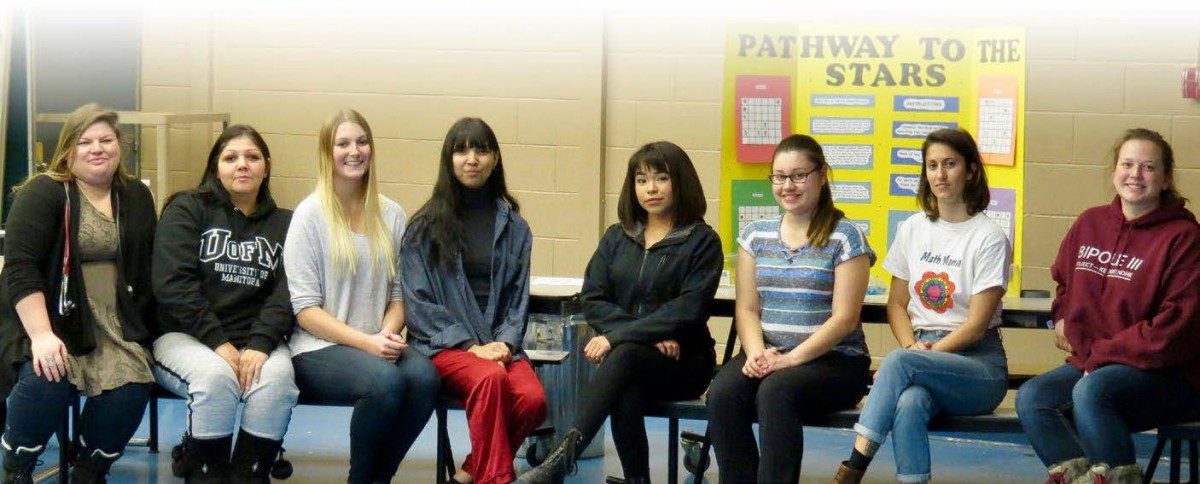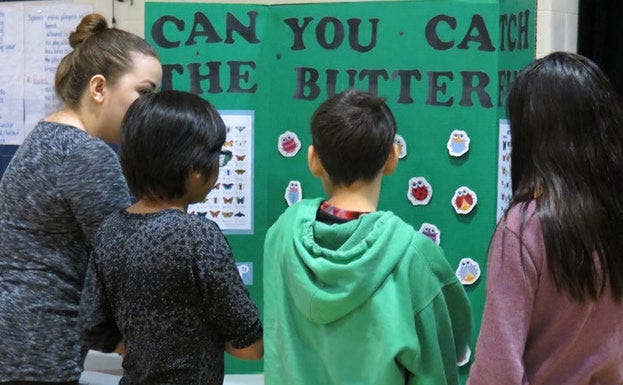
Darja Barr (second from right) and the team of volunteers
The Power of relationship building for Indigenous youth
Addressing the complex issue of underrepresentation of Indigenous youth in post-secondary studies, and STEM fields
Darja Barr, Department of Mathematics, and Outreach Educator with the Pacific Institute for Mathematical Science (PIMS) outlines new recruitment initiatives at the University of Manitoba to attract and support Indigenous youth.
As (PIMS) reports:
At post secondary institutions across Canada, the recruitment and retention of Indigenous and First Nations students is receiving ever more attention and resources (4–12). At the University of Manitoba, one of the Five Strategic Priorities that are laid out in our strategic plan is Creating Pathways for Indigenous Achievement. In this section, the University outlines its commitment to “building a culturally rich, safe and supportive learning and work environment in which an increasing number of Indigenous students, faculty and staff succeed” through increasing Indigenous student enrolment and increasing Indigenous student retention and graduation rates. However, in Manitoba, as of 2011, those identifying as Indigenous or Aboriginal peoples made up around 17% of the population, and census data predicts that this number will increase to 19% by 2026. On the other hand, at the University of Manitoba, our student body in 2016 was made up of only 8% Indigenous or Aboriginal identifying peoples. Clearly, this group is underrepresented at our University—and continues to be—despite significant efforts to increase numbers and graduation rates. This reflects a broader trend where Indigenous students and other minorities are underrepresented and have lower retention rates in STEM (Science, Technology, Engineering and Math) programs across North America.
There are many complex issues associated with the underrepresentation of Indigenous peoples in post-secondary education. In fact, the transition from high school to university is difficult for many students because of the differences in expectations, environment, teaching style, and a variety of other factors. These challenges are only enhanced for students who come from First Nations communities, where the culture and environment may be very different than that experienced on a university campus. Thus, faculty members across a variety of Departments are being encouraged to explore different ways to attract and retain Indigenous students, as well as support them towards achieving success.

In the Department of Mathematics, we have a somewhat unique challenge in that not only are Indigenous students highly underrepresented in our field and in our courses, but that the incoming mathematical knowledge of our students from First Nations communities is highly varied. These students may not have had access to high school mathematics courses or teachers with strong mathematical backgrounds. This in turn can lead to difficulty completing first year mathematics requirements, leading to withdrawal from courses, programs of choice, and the university in general. This reality motivated us to seek opportunities to link with other Faculties whose Indigenous students were taking first year mathematics courses as a gateway into their field of choice. One of these was the College of Nursing. Through partnership and a joint sense of purpose we were able to collaboratively develop a program which addressed Indigenous Nursing hopefuls’ struggles with university mathematics within the orientation program that they were already offering. The hope was that this joint effort would result in increased success in both their coursework and retention in the Nursing program.
The Aboriginal Nursing Cohort Initiative
At the University of Manitoba, the Aboriginal Nursing Cohort Initiative (ANCI), the College of Nursing and the Department of Mathematics came together to develope a program that aimed to increase student success overall, and more specifically in Applied Finite Mathematics (MATH 1010). This mathematics course has long been a significant barrier to the ability of students in this cohort to successfully be accepted into the Nursing Program. In the summer of 2015, the Faculty of Nursing approached the Department of Mathematics and the Dean’s office of the Faculty of Science to begin a strategic partnership that would address the cohort’s struggles with mathematics.
Rather than attempting to remove or bypass the mathematics requirement for their students, the ANCI team was dedicated to supporting students in mathematics and to cooperating with our Department in any way necessary to achieve success. In the fall of 2015, the first attempt to improve ANCI student performance in MATH 1010 consisted of creating a special section of the course, reserved for the ANCI students only. The thought was that these students would feel more comfortable in a small classroom environment, surrounded by their peers, rather than in the typical, large (100+) classes. Though there was no significant change in student outcomes from the previous class format to the small class format, the students expressed their preference for the small classes.
After the term, we again came together to reflect and rethink our approach. This time, we wanted to align with research that has identified various factors that can enhance the experiences (and thus retention and persistence) of Indigenous students at university, and specifically in STEM disciplines. Some of these factors include:
1. Building strategic partnerships,
2. Reinforcing cultural identity,
3. Creating opportunities to connect with other Indigenous students,
4. Building relationships between faculty and Indigenous students.
Read the full article click here.






